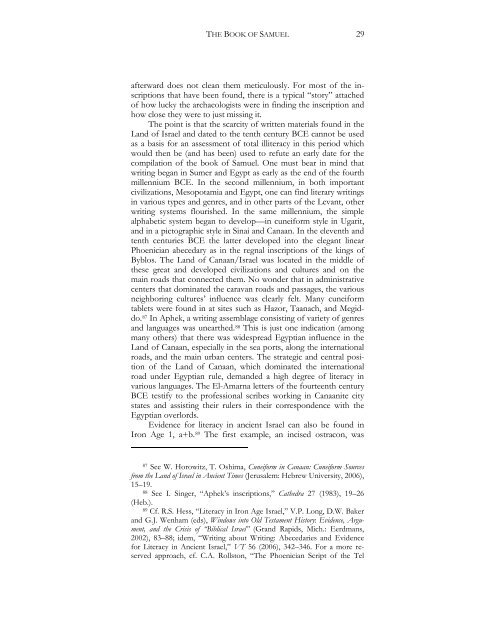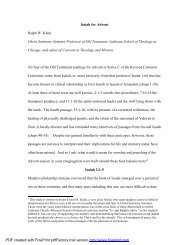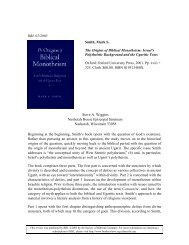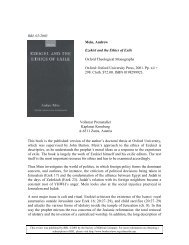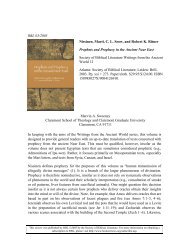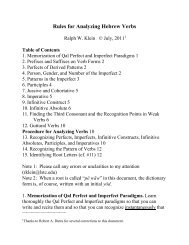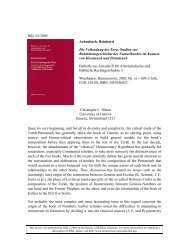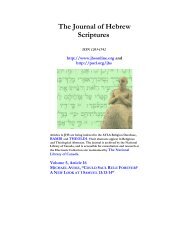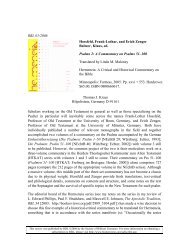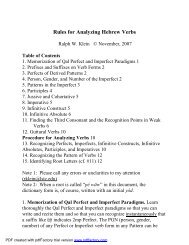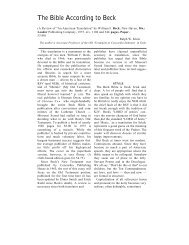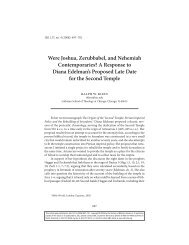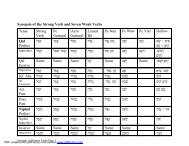The Book of Samuel: Its Composition, Structure and Significance as ...
The Book of Samuel: Its Composition, Structure and Significance as ...
The Book of Samuel: Its Composition, Structure and Significance as ...
Create successful ePaper yourself
Turn your PDF publications into a flip-book with our unique Google optimized e-Paper software.
THE BOOK OF SAMUEL<br />
afterward does not clean them meticulously. For most <strong>of</strong> the inscriptions<br />
that have been found, there is a typical “story” attached<br />
<strong>of</strong> how lucky the archaeologists were in finding the inscription <strong>and</strong><br />
how close they were to just missing it.<br />
<strong>The</strong> point is that the scarcity <strong>of</strong> written materials found in the<br />
L<strong>and</strong> <strong>of</strong> Israel <strong>and</strong> dated to the tenth century BCE cannot be used<br />
<strong>as</strong> a b<strong>as</strong>is for an <strong>as</strong>sessment <strong>of</strong> total illiteracy in this period which<br />
would then be (<strong>and</strong> h<strong>as</strong> been) used to refute an early date for the<br />
compilation <strong>of</strong> the book <strong>of</strong> <strong>Samuel</strong>. One must bear in mind that<br />
writing began in Sumer <strong>and</strong> Egypt <strong>as</strong> early <strong>as</strong> the end <strong>of</strong> the fourth<br />
millennium BCE. In the second millennium, in both important<br />
civilizations, Mesopotamia <strong>and</strong> Egypt, one can find literary writings<br />
in various types <strong>and</strong> genres, <strong>and</strong> in other parts <strong>of</strong> the Levant, other<br />
writing systems flourished. In the same millennium, the simple<br />
alphabetic system began to develop—in cuneiform style in Ugarit,<br />
<strong>and</strong> in a pictographic style in Sinai <strong>and</strong> Canaan. In the eleventh <strong>and</strong><br />
tenth centuries BCE the latter developed into the elegant linear<br />
Phoenician abecedary <strong>as</strong> in the regnal inscriptions <strong>of</strong> the kings <strong>of</strong><br />
Byblos. <strong>The</strong> L<strong>and</strong> <strong>of</strong> Canaan/Israel w<strong>as</strong> located in the middle <strong>of</strong><br />
these great <strong>and</strong> developed civilizations <strong>and</strong> cultures <strong>and</strong> on the<br />
main roads that connected them. No wonder that in administrative<br />
centers that dominated the caravan roads <strong>and</strong> p<strong>as</strong>sages, the various<br />
neighboring cultures’ influence w<strong>as</strong> clearly felt. Many cuneiform<br />
tablets were found in at sites such <strong>as</strong> Hazor, Taanach, <strong>and</strong> Megiddo.<br />
87 In Aphek, a writing <strong>as</strong>semblage consisting <strong>of</strong> variety <strong>of</strong> genres<br />
<strong>and</strong> languages w<strong>as</strong> unearthed. 88 This is just one indication (among<br />
many others) that there w<strong>as</strong> widespread Egyptian influence in the<br />
L<strong>and</strong> <strong>of</strong> Canaan, especially in the sea ports, along the international<br />
roads, <strong>and</strong> the main urban centers. <strong>The</strong> strategic <strong>and</strong> central position<br />
<strong>of</strong> the L<strong>and</strong> <strong>of</strong> Canaan, which dominated the international<br />
road under Egyptian rule, dem<strong>and</strong>ed a high degree <strong>of</strong> literacy in<br />
various languages. <strong>The</strong> El-Amarna letters <strong>of</strong> the fourteenth century<br />
BCE testify to the pr<strong>of</strong>essional scribes working in Canaanite city<br />
states <strong>and</strong> <strong>as</strong>sisting their rulers in their correspondence with the<br />
Egyptian overlords.<br />
Evidence for literacy in ancient Israel can also be found in<br />
Iron Age 1, a+b. 89 <strong>The</strong> first example, an incised ostracon, w<strong>as</strong><br />
87 See W. Horowitz, T. Oshima, Cuneiform in Canaan: Cuneiform Sources<br />
from the L<strong>and</strong> <strong>of</strong> Israel in Ancient Times (Jerusalem: Hebrew University, 2006),<br />
15–19.<br />
88 See I. Singer, “Aphek’s inscriptions,” Cathedra 27 (1983), 19–26<br />
(Heb.).<br />
89 Cf. R.S. Hess, “Literacy in Iron Age Israel,” V.P. Long, D.W. Baker<br />
<strong>and</strong> G.J. Wenham (eds), Windows into Old Testament History: Evidence, Argument,<br />
<strong>and</strong> the Crisis <strong>of</strong> “Biblical Israel” (Gr<strong>and</strong> Rapids, Mich.: Eerdmans,<br />
2002), 83–88; idem, “Writing about Writing: Abecedaries <strong>and</strong> Evidence<br />
for Literacy in Ancient Israel,” VT 56 (2006), 342–346. For a more reserved<br />
approach, cf. C.A. Rollston, “<strong>The</strong> Phoenician Script <strong>of</strong> the Tel<br />
29


